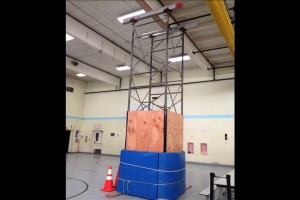Schools becoming a “fixer-upper”
Like many schools of its era, Harry Kirzirian Elementary off Chalkstone Avenue needs a lot more than a facelift. From the outside, the school looks like it was built in 1959. But it isn’t until a visit inside that you truly appreciate the challenging conditions that teachers, staff and 600 children face every day.
Last August, just as school was beginning, heavy rains caused part of the building’s flat roof to cave in; water cascaded into room 204. Despite efforts to replace tiles and carpeting there has been a persistent mold problem. You can see it in other parts of the building as well.
It’s been so bad that the veteran teacher in room 204, who has been at Kizirian for a dozen years, had to take 16 sick days this year alone to fight multiple bouts of bronchitis. Every time she’s come back, respiratory problems, and exhaustion, have returned as well.
“It has a tremendous effect on the morale and the climate and culture of a building,’’ says Steve Smith, the outgoing president of the Providence Teachers Union. The union filed a grievance over the conditions at Kizirian and is fighting to have the teacher’s sick time reinstated for the days missed. Her allergist called the teacher’s classroom a toxic environment.
But it’s not just the roof in 204. A brace surrounded by scaffolding greets everyone who uses the cafeteria, which doubles as a gym. It was installed three years ago to prop up the ceiling. At first the kids thought it was meant for climbing, so officials put in padding and orange cones as a warning. The only thing missing is yellow police tape.
Joseph DiPina, chief of administration for the Providence School Department, says the average age of the department’s buildings is 58 years old and admits many are showing their age. He says while the school department is addressing day-to-day problems, the city owns the school buildings and is ultimately the landlord.
The solution to the cafeteria scaffolding alone would cost half a million dollars and speaks to a larger issue of what condition schools in Providence and across the state are in after the General Assembly passed a school construction moratorium in 2011. It eliminated a state reimbursement making it financially attractive for local communities to invest in their facilities.
The moratorium brought most construction and renovations to an abrupt halt.
“The first thing to go in budgets, since I was a teacher, let alone union president, is maintenance,’’ said Smith. “And as the buildings get older the maintenance costs increase. This is a money problem. I know sometimes people don’t want to hear that, but it’s really a money problem.’’
That has been particularly true in Providence, where the oldest building is the Broad Street School, dating to 1895. The new Providence Career and Technical Academy is the crown jewel of the district, opening just before the school construction. The department also overhauled Central High next door. Then the money dried up. That moratorium is scheduled to expire later this year and Smith says the General Assembly should be wary of extending it.
The Rhode Island Department of Education last year commissioned a study looking at the conditions of school facilities statewide. The picture is not pretty in Providence, which has 3.5 million square feet of space to maintain every year.
DiPina said Providence is constantly evaluating its buildings. “We assist the city in identifying projects, and we characterize them as warm, safe and dry. That will satisfy the most basic needs of the students.’’
Hummel: As of today are most of your schools, or all of your schools, warm, safe and dry?
DiPina: I wouldn’t say that as of today they’re all there. We do have some schools that have some pressing issues.
Warm, safe and dry has been a challenge at Kizirian. A $1,500 air quality study recently completed for the district showed no mold problems, but indicated high levels of carbon dioxide in room 204, even when no one was in the room. The teacher reported through her union that many of her students are lethargic and often fall asleep in class. The district’s short-term solution? Crack a few windows. And she can’t move to another classroom because the building is full.
Smith, the union president, said, “You have people who are dedicated. They come to work every day, they want to be in work and they want to do their job. Sometimes they accept conditions that teachers elsewhere would not.’’
We asked DiPina, from the Providence School Department, if he would send his son to Kizirian Elementary.
DiPina: I would feel comfortable with my son going to any of the schools in Providence.
Hummel: That specific room that you looked in, where there have been high carbon dioxide levels. What if your child was in that classroom?
DiPina: Again, if I knew that the school and district was doing its due diligence to ensure a safe community for the children there, I would feel comfortable sending my child there.
It’s a situation, Smith says, the city can’t put off any longer. “This shouldn’t be looked at as pouring money into a situation. This is an investment. Why wouldn’t we want to do this and do it well? Because the money creates environments where you’re going to retain the best teachers. Children are going to want to be in that environment and will thrive in that environment. You’re going to save costs in years to come.’’
The Hummel Report is a 501 3C non-profit organization that relies, in part, on your donations. If you have a story idea or want make a donation go to www.hummelreport.org, where you can also see the video version of this story. You can mail Jim directly at jim@hummelreport.org.

